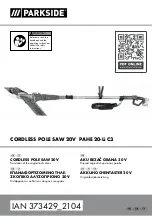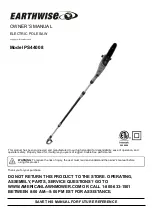
Page 4
Item 97360
For technical questions, please call 1-888-866-5797.
5.
Use only 3-wire extension cords that
have 3-prong grounding plugs and 3-pole
receptacles that accept the tool’s plug.
6.
Repair or replace damaged or
worn cord immediately.
125 VAC 3-Prong Plug and Outlet
(for up to 125 VAC and up to 15 A)
Grounding
Pin
7.
This tool is intended for use on a circuit
that has an outlet that looks like the one
illustrated above in
125 VAC 3-Prong Plug
and Outlet
. The tool has a grounding plug
that looks like the plug illustrated above
in
125 VAC 3-Prong Plug and Outlet
.
8.
The outlet must be properly installed
and grounded in accordance with
all codes and ordinances.
9.
Do not use an adapter to connect
this tool to a different outlet.
110-120 VAC Double
Insulated Tools: Tools
with Two Prong Plugs
Outlets for 2-Prong Plug
1.
To reduce the risk of electric shock, double
insulated equipment has a polarized plug
(one blade is wider than the other). This
plug will fit in a polarized outlet only one
way. If the plug does not fit fully in the outlet,
reverse the plug. If it still does not fit, contact
a qualified electrician to install the proper
outlet. Do not change the plug in any way.
2.
Double insulated tools may be used in either
of the 120 volt outlets shown in the preceding
illustration.
(See Outlets for 2-Prong Plug.)
Tile Saw Safety Warnings
For Your Own Safety Read Instruction
Manual Before Operating Saw
1.
Wear eye protection.
2.
Use saw-blade guard and spreader
for every operation for which it can be
used, including all through sawing.
3.
Keep hands out of the line of saw blade.
4.
Know how to reduce risk of kickback.
5.
Do not perform any operation freehand.
6.
Never reach around or over saw blade.
7.
Make sure the workpiece is supported
at all times while sawing.
8.
To properly understand all safety
warnings, be familiar with the following
safety terms and equipment:
a. Featherboard – A block with
“fingers” that hold the workpiece
against the fence while sawing.
b. Through-sawing – A cut made from
one side of a tile to the opposite
side, without stopping.
c. Freehand – Feeding a workpiece through
the saw without using a fence or guided
support to guide it.
NOT A SAFE METHOD.
d. Kerf – The gap made by the
saw in the workpiece.
e. Kickback – A sudden reaction to a pinched,
bound, or misaligned blade, causing
an uncontrolled workpiece to lift up and
out of the saw toward the operator.
f. Spreader – A metal plate that follows
the saw blade to keep the kerf (gap)
from closing on the saw blade.
Spreaders, except riving knives, must





































